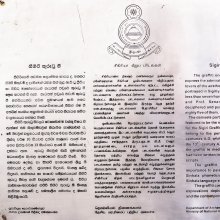Kavyalankara, Kāvyālaṅkāra, Kāvyālaṅkārā, Kāvyālaṃkāra, Kāvyālaṃkārā, Kavyalamkara, Kavya-alankara, Kavya-alamkara: 6 definitions
Introduction:
Kavyalankara means something in Hinduism, Sanskrit. If you want to know the exact meaning, history, etymology or English translation of this term then check out the descriptions on this page. Add your comment or reference to a book if you want to contribute to this summary article.
Images (photo gallery)
In Hinduism
Kavya (poetry)
Source: Wisdom Library: KathāsaritsāgaraKāvyālaṅkārā (काव्यालङ्कारा) is one of the two wifes of king Parityāgasena, according to the Kathāsaritsāgara, chapter 42. Accordingly, “... and he [Parityāgasena] had two beloved queens, whom he valued as his life. One was the daughter of his own minister, and her name was Adhikasaṅgamā; and the other was of royal race, and was called Kāvyālaṅkārā. And with those two the king propitiated Durgā to obtain a son, and performed penance without food, sleeping on darbha grass.”.
The story of Kāvyālaṅkārā and Parityāgasena was narrated by Gomukha to Naravāhanahatta in order to demonstrate that “the great must endure great pains and gain great glory, but others have little pain and little glory”.
The Kathāsaritsāgara (‘ocean of streams of story’), mentioning Kāvyālaṅkārā, is a famous Sanskrit epic story revolving around prince Naravāhanadatta and his quest to become the emperor of the vidyādharas (celestial beings). The work is said to have been an adaptation of Guṇāḍhya’s Bṛhatkathā consisting of 100,000 verses, which in turn is part of a larger work containing 700,000 verses.

Kavya (काव्य, kavya) refers to Sanskrit poetry, a popular ancient Indian tradition of literature. There have been many Sanskrit poets over the ages, hailing from ancient India and beyond. This topic includes mahakavya, or ‘epic poetry’ and natya, or ‘dramatic poetry’.
Languages of India and abroad
Sanskrit dictionary
Source: DDSA: The practical Sanskrit-English dictionaryKāvyālaṅkāra (काव्यालङ्कार).—Name of a work on poetics by Vāmana.
Derivable forms: kāvyālaṅkāraḥ (काव्यालङ्कारः).
Kāvyālaṅkāra is a Sanskrit compound consisting of the terms kāvya and alaṅkāra (अलङ्कार).
Source: Cologne Digital Sanskrit Dictionaries: Cappeller Sanskrit-English DictionaryKāvyālaṃkāra (काव्यालंकार).—[masculine] ornament of poetry, T. of a work = seq.
Source: Cologne Digital Sanskrit Dictionaries: Aufrecht Catalogus Catalogorum1) Kāvyālaṃkāra (काव्यालंकार) as mentioned in Aufrecht’s Catalogus Catalogorum:—by Rudraṭa. Kh. 87. Report. Xvi. Ben. 34. Bik. 284. Rādh. 24. Oudh. Xi, 10. Peters. 1, 118. Quoted by Mammaṭa Oxf. 212^b, in Alaṃkārasarvasva Oxf. 210^a, in Kāvyacandrikā Oxf. 211^b.
—[commentary] Vanataraṅgiṇī. Oppert. 2761. 2787.
—[commentary] by Āśādhara. Rādh. 46. Peters. 2, 85. Bühler 542.
—[commentary] by Nami. Kh. 34. Report. p. 67. Peters. 1, 159.
2) Kāvyālaṃkāra (काव्यालंकार):—by Rudraṭa. add Rādh. 46. Bu7hler 542. Quoted by Mammaṭa Oxf. 212^a. Kh. 87 gives only an anonymous
—[commentary].
—[commentary] Vanataraṅgiṇī read Oppert. Ii,
—[commentary] by Āśādhara. delete Rādh. 46. Bu7hler 542.
—[commentary] by Nami. add L. 3102. read Peters. 1, 118.
3) Kāvyālaṃkāra (काव्यालंकार):—by Rudraṭa. L. 3328.
—[commentary] by Nami. L. 3324. Stein 61.
4) Kāvyālaṃkāra (काव्यालंकार):—by Vāmana. Bc 306. Hz. 845. C. Kāvyālaṃkārakāmadhenu by Gopendra. Bc 306.
Source: Cologne Digital Sanskrit Dictionaries: Monier-Williams Sanskrit-English DictionaryKāvyālaṃkāra (काव्यालंकार):—[from kāvya] m. Name of [work] on poetics by Vāmana
Sanskrit, also spelled संस्कृतम् (saṃskṛtam), is an ancient language of India commonly seen as the grandmother of the Indo-European language family (even English!). Closely allied with Prakrit and Pali, Sanskrit is more exhaustive in both grammar and terms and has the most extensive collection of literature in the world, greatly surpassing its sister-languages Greek and Latin.
Kannada-English dictionary
Source: Alar: Kannada-English corpusKāvyālaṃkāra (ಕಾವ್ಯಾಲಂಕಾರ):—[noun] an expression, as a metaphor or simile, using words in a nonliteral sense or unusual manner to add vividness, beauty, etc. to what is said or written; a figure of speech.
Kannada is a Dravidian language (as opposed to the Indo-European language family) mainly spoken in the southwestern region of India.
See also (Relevant definitions)
Partial matches: Alamkara, Kavya.
Full-text (+32): Rudrata, Kavyalamkriti, Bhamaha, Kavyalamkaravritti, Nikrishti, Chalita, Vamanasutravritti, Vamanavritti, Gaudi, Kanthabhushana kavyalamkara, Patalavijaya, Tilakamanjari, Vaidarbhi, Medhavirudra, Gopendra, Shishuprabodha kavyalamkara, Shabdashuddhi, Nami, Viradeva, Vishnudasa.
Relevant text
Search found 24 books and stories containing Kavyalankara, Kavya-alamkara, Kāvya-alaṃkāra, Kavya-alankara, Kāvya-alaṅkāra, Kāvyālaṃkāra, Kāvyālaṃkārā, Kavyalamkara, Kāvyālaṅkāra, Kāvyālaṅkārā; (plurals include: Kavyalankaras, alamkaras, alaṃkāras, alankaras, alaṅkāras, Kāvyālaṃkāras, Kāvyālaṃkārās, Kavyalamkaras, Kāvyālaṅkāras, Kāvyālaṅkārās). You can also click to the full overview containing English textual excerpts. Below are direct links for the most relevant articles:
Kavyamimamsa of Rajasekhara (Study) (by Debabrata Barai)
Part 7 - Kāvyālaṃkāra of Rudraṭa < [Chapter 2 - A General Outlines of Sanskrit Poetics]
Part 3 - Kāvyālaṃkāra of Bhāmaha < [Chapter 2 - A General Outlines of Sanskrit Poetics]
Part 19 - Rājaśekhara’s Earlier Work’s on Kavi-śikṣā < [Chapter 2 - A General Outlines of Sanskrit Poetics]
Bhajana-Rahasya (by Srila Bhaktivinoda Thakura Mahasaya)
Text 1 < [Chapter 4 - Caturtha-yāma-sādhana (Madhyāhna-kālīya-bhajana–ruci-bhajana)]
Alamkaras mentioned by Vamana (by Pratim Bhattacharya)
2: Alaṃkāra-śāstra according to Bharata (2nd century B.C.) < [Chapter 2 - The concept of alaṃkāra in Sanskrit Poetics]
3: Alaṃkāra-śāstra according to Bhāmaha (7th century) < [Chapter 2 - The concept of alaṃkāra in Sanskrit Poetics]
5: Alaṃkāra-śāstra according to Rudraṭa (9th century) < [Chapter 2 - The concept of alaṃkāra in Sanskrit Poetics]
Sahitya-kaumudi by Baladeva Vidyabhushana (by Gaurapada Dāsa)
Text 8.17 < [Chapter 8 - Literary Qualities]
Text 7.113 < [Chapter 7 - Literary Faults]
Text 9.51 < [Chapter 9 - Ornaments of Sound]
Kuntaka’s evaluation of Sanskrit literature (by Nikitha. M)
Origin and development of Sanskrit poetics < [Introduction]
2. The concept of vakrokti in earlier poeticians < [Chapter 1 - Vakroktijīvita: A Synoptic Survey]
4. Uttararāmacarita in Kuntaka’s treatment < [Chapter 4 - Kuntaka’s evaluation of Sanskrit Plays of other Poets]
Amarakoshodghatana of Kshirasvamin (study) (by A. Yamuna Devi)
Miscellaneous (2): Varieties of poison (Viṣabheda) < [Chapter 3 - Social Aspects]
